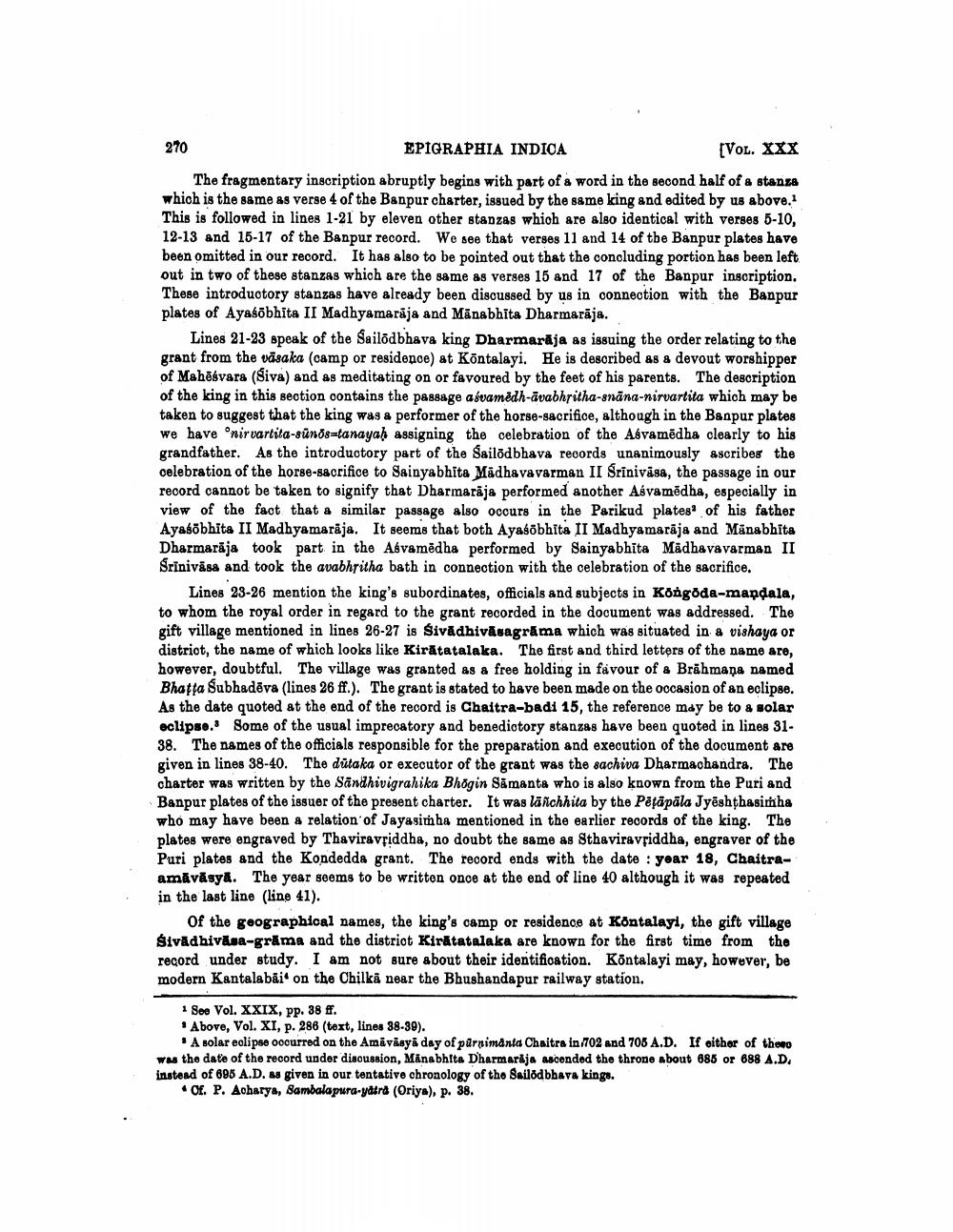________________
270 EPIGRAPHIA INDICA
[Vol. XXX The fragmentary inscription abruptly begins with part of a word in the second half of a stanza which is the same as verge 4 of the Banpur charter, issued by the same king and edited by us above. This is followed in lines 1-21 by eleven other stanzas which are also identical with verses 5-10, 12-13 and 15-17 of the Banpur record. We see that verses 11 and 14 of the Banpur plates have been omitted in our record. It has also to be pointed out that the concluding portion has been left out in two of these stanzas which are the same as verses 15 and 17 of the Banpur inscription. These introductory stanzas have already been discussed by us in connection with the Banpur plates of Ayasobhita II Madhyamarāja and Mānabhita Dharmarāja.
Lines 21-23 speak of the Sailodbhava king Dharmarāja as issuing the order relating to the grant from the vāsaka (camp or residence) at Köntalayi. He is described as a devout worshipper of Mahē vara (Siva) and as meditating on or favoured by the feet of his parents. The description of the king in this section oontains the passage asvamedh-avabhritha-enäna-nirvartita which may be taken to suggest that the king was a performer of the horse-sacrifice, although in the Banpur plates we have nirvartita-sünös=tanayah assigning the celebration of the Asvamēdha clearly to his grandfather. As the introductory part of the Sailodbhava records unanimously ascribes the celebration of the horse-sacrifice to Sainyabhita Madhavavarman II Srinivāsa, the passage in our record cannot be taken to signify that Dharmarāja performed another Asvamēdha, especially in view of the fact that a similar passage also occurs in the Parikud plates' of his father Ayasöbhita II Madhyamarāja. It seems that both Ayasobhita II Madhyamarāja and Mānabhita Dharmaraja took part in the Abvamēdha performed by Sainyabhīta Madhavavarman II Sriniväss and took the avabhritha bath in connection with the celebration of the sacrifice.
Lines 23-26 mention the king's subordinates, officials and subjects in Kongoda-mandala, to whom the royal order in regard to the grant recorded in the document was addressed. The gift village mentioned in lines 26-27 is Śivadhivāsagrāma which was situated in a vishaya or district, the name of which looks like Kirātatalaka. The first and third letters of the name are, however, doubtful. The village was granted as a free holding in favour of a Brāhmaṇa named Bhatta Subhadēva (lines 26 ff.). The grant is stated to have been made on the occasion of an eclipse. As the date quoted at the end of the record is Chaitra-badi 15, the reference may be to & solar eclipse. Some of the usual imprecatory and benedictory stanzas have been quoted in lines 3138. The names of the officials responsible for the preparation and execution of the document are given in lines 38-40. The dütaka or executor of the grant was the sachiva Dharmachandra. The charter was written by the Sandhivigrahika Bhögin Samanta who is also known from the Puri and Banpur plates of the issuer of the present charter. It was lanchhita by the Pējāpāla Jyēshţhasimha who may have been a relation of Jayasimha mentioned in the earlier records of the king. The plates were engraved by Thaviravriddha, no doubt the same as Sthaviravşiddha, engraver of the Puri plates and the Kondedda grant. The record ends with the date : year 18, Chaitraamāvāsya. The year seems to be written once at the end of line 40 although it was repeated in the last line (line 41).
of the geographical names, the king's camp or residence at Kontalayi, the gift village Śivadhivāsa-grama and the district Kirātatalaka are known for the first time from the record under study. I am not sure about their identification. Kontalayi may, however, be modern Kantalabāi' on the Chilkā near the Bhushandapur railway station,
1 See Vol. XXIX, pp. 38 f. . Above, Vol. XI, p. 286 (text, lines 88-39).
A solar eclipse oocurred on the Amavasyā day of purnimanta Chaitra in /702 and 706 A.D. If either of theo was the date of the record under discussion, Mänabhita Dharmaraja ascended the throne about 685 or 688 A.D. instead of 695 A.D. as given in our tentative chronology of the Sailodbhava kings.
Of. P. Acharya, Sambalapura-yderd (Oriya), p. 38.




